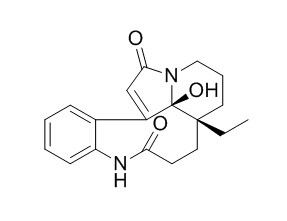Leuconolam
Standard reference
Inquire / Order:
manager@chemfaces.com
Technical Inquiries:
service@chemfaces.com
Tel:
+86-27-84237783
Fax:
+86-27-84254680
Address:
1 Building, No. 83, CheCheng Rd., Wuhan Economic and Technological Development Zone, Wuhan, Hubei 430056, PRC
Providing storage is as stated on the product vial and the vial is kept tightly sealed, the product can be stored for up to
24 months(2-8C).
Wherever possible, you should prepare and use solutions on the same day. However, if you need to make up stock solutions in advance, we recommend that you store the solution as aliquots in tightly sealed vials at -20C. Generally, these will be useable for up to two weeks. Before use, and prior to opening the vial we recommend that you allow your product to equilibrate to room temperature for at least 1 hour.
Need more advice on solubility, usage and handling? Please email to: service@chemfaces.com
The packaging of the product may have turned upside down during transportation, resulting in the natural compounds adhering to the neck or cap of the vial. take the vial out of its packaging and gently shake to let the compounds fall to the bottom of the vial. for liquid products, centrifuge at 200-500 RPM to gather the liquid at the bottom of the vial. try to avoid loss or contamination during handling.
Industrial Crops and Products2022, 188:115638
Food Research International2020, 108987
Plants (Basel).2021, 10(11):2317.
PLoS One.2022, 17(6):e0268505.
Appl. Sci.2020, 10(16),5482.
Life Sci.2022, 298:120488.
Indian J. of Experimental Bio.2020, 9(58).
Nat Prod Sci.2019, 25(3):238
Int J Mol Sci.2022, 23(5):2796.
Korean J Environ Agric.2018, 37(4):260-267
Related and Featured Products
J Nat Prod. 2017 Apr 28;80(4):1007-1014
Revisiting Previously Investigated Plants: A Molecular Networking-Based Study of Geissospermum laeve.[Pubmed:
28282127]
Three new monoterpene indole alkaloids (1-3) have been isolated from the bark of Geissospermum laeve, together with the known alkaloids (-)-Leuconolam (4), geissolosimine (5), and geissospermine (6).
METHODS AND RESULTS:
The structures of 1-3 were elucidated by analysis of their HRMS and NMR spectroscopic data. The absolute configuration of geissolaevine (1) was deduced from the comparison of experimental and theoretically calculated ECD spectra. The isolation workflow was guided by a molecular networking-based dereplication strategy using an in-house database of monoterpene indole alkaloids. In addition, five known compounds previously undescribed in the Geissospermum genus were dereplicated from the G. laeve alkaloid extract network and were assigned with various levels of identification confidence. The antiparasitic activities against Plasmodium falciparum and Leishmania donovani as well as the cytotoxic activity against the MRC-5 cell line were determined for compounds 1-5.
J Nat Prod. 2014 Feb 28;77(2):327-38.
Transformations of the 2,7-Seco Aspidosperma alkaloid leuconolam, structure revision of epi-leuconolam, and partial syntheses of leuconoxine and leuconodines A and F.[Pubmed:
24428198]
METHODS AND RESULTS:
Several transformations of the seco Aspidosperma alkaloid Leuconolam were carried out. The based-induced reaction resulted in cyclization to yield two epimers, the major product corresponding to the optical antipode of a (+)-meloscine derivative. The structures and relative configuration of the products were confirmed by X-ray diffraction analysis. Reaction of Leuconolam and epi-Leuconolam with various acids, molecular bromine, and hydrogen gave results that indicated that the structure of the alkaloid, previously assigned as epi-Leuconolam, was incorrect.
CONCLUSIONS:
This was confirmed by an X-ray diffraction analysis, which revealed that epi-Leuconolam is in fact 6,7-dehydroleuconoxine. Short partial syntheses of the diazaspiro indole alkaloid leuconoxine and the new leuconoxine-type alkaloids leuconodines A and F were carried out.
Org Lett. 2014 Dec 5;16(23):6216-9.
Biosynthetically inspired divergent approach to monoterpene indole alkaloids: total synthesis of mersicarpine, leuconodines B and D, leuconoxine, melodinine E, leuconolam, and rhazinilam.[Pubmed:
25412144]
METHODS AND RESULTS:
Inspired by their potential biosynthesis, we have developed divergent total syntheses of seven monoterpene indole alkaloids including mersicarpine, leuconodines B and D, leuconoxine, melodinine E, Leuconolam, and rhazinilam, and one unnatural analogue with an unprecedented structural skeleton.
CONCLUSIONS:
The key steps involve a Witkop-Winterfeldt oxidative indole cleavage followed by transannular cyclization. The transannular cyclization product was then converted to the corresponding structural skeletons by pairing its functional groups into different reaction modes.



